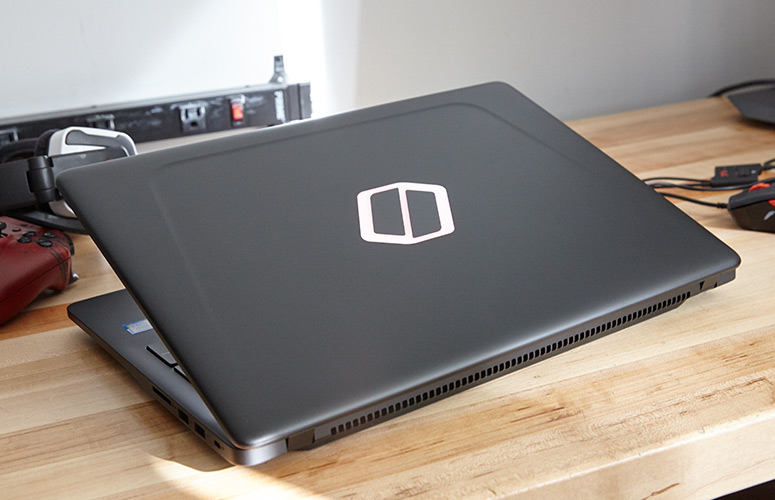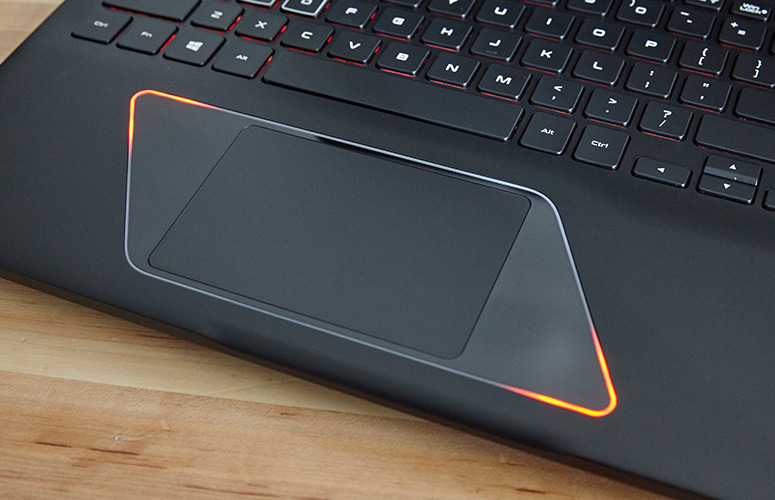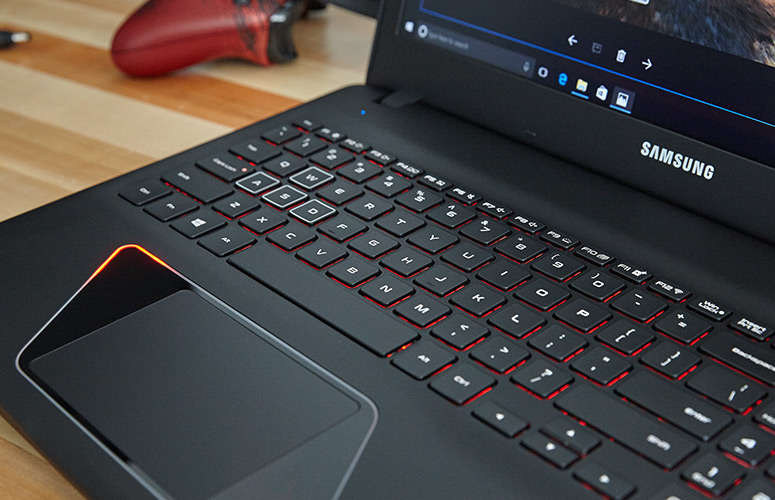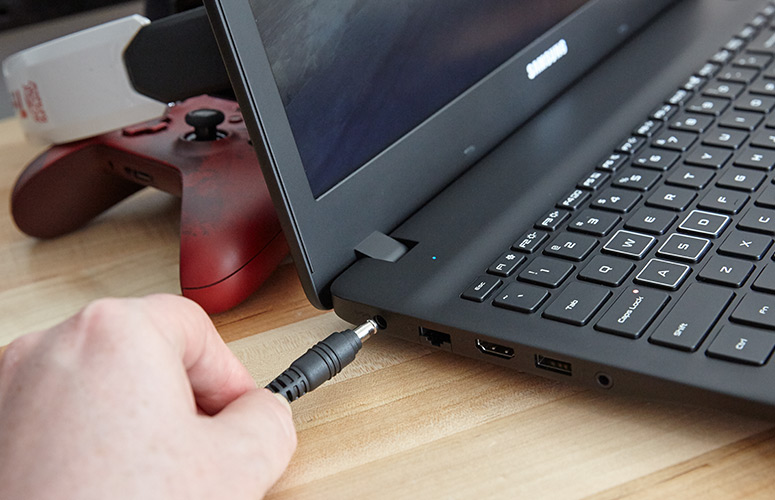Laptop Mag Verdict
The Samsung Notebook Odyssey performs as well as other gaming notebooks in its class, but it's overpriced, feels cheap and looks gaudy.
Pros
- +
Solid productivity and gaming performance
Cons
- -
Overpriced; Looks and feels cheap; Annoying touchpad ring; Fans go constantly; Dim display
Why you can trust Laptop Mag
Some trips aren't worth taking. Case in point: the Samsung Notebook Odyssey ($1,199.99 as tested; up to $1,399.99). It's outfitted with a powerful Intel Core i7 processor and Nvidia GeForce GTX 1050 GPU to try to take on the big names like Asus and Lenovo. But the Odyssey doesn't make a good first impression, thanks to its cheap looks and build, and the lackluster screen doesn't do it any favors. It has decent performance, but you can do better at this price or less.
Design: Plastic, Not Premium
The plastic feels like something you'd find on a cheap toy, not a $1,200 gaming machine.
My first impression of the Odyssey was that it looks cheap and gaudy. Then I touched it, and found that it feels cheap, too. The lid is a slab of black plastic with a small raised bump for decoration. It features Samsung's new Odyssey logo in the center, a sort of rounded hexagon that's completely uninspired, but also inoffensive (one colleague suggested, at first glance, that it made the laptop look like an off-brand knockoff).
The plastic feels like something you'd find on a cheap toy, not a $1,200 gaming machine. It's not much better once you lift the lid. First, you'll find the 15.6-inch, 1080p display and a full, red backlit keyboard with number pad, which all seems completely normal. But then you get to the trackpad. It's surrounded by a plastic rhombus cutout with red on both ends. It's ugly, and even worse, misleading, as it doesn't do anything (more on this below).
It's not all horrible, though. I do appreciate the use of rounded edges, especially when so many gaming laptops use jagged lines to prove they're tough. The "Hexaflow" vents on the bottom of the machine do admittedly look cool, but you'll rarely see them. Those refinements don't get me past the fact that this is the chassis looks like something straight out of Hot Topic.
On the left side of the laptop, you'll find the power port, Ethernet jack, an HDMI port, a USB 3.0 port and a headphone jack. On the right side, are an SD card slot, a pair of USB 2.0 ports and a Kensington lock slot. Those USB ports aren't labeled, though, so I'm admittedly taking Samsung's word for it. I had to guess which one was the USB 3.0 port and email the company to get a conclusive answer.
At 5.4 pounds and 14.9 x 10.2 x 0.9 inches, the Odyssey is a little smaller than competing laptops. The Lenovo Legion Y520 is 15 x 10.4 x 1 inches and 5.6 pounds, while the Asus ROG Strix GL553VD is 15.1 x 10 x 1.2 inches and 5.6 pounds. The Dell Inspiron 15 7000 is the largest, at 5.8 pounds and 15.2 x 10.8 x 1 inches.
Sign up to receive The Snapshot, a free special dispatch from Laptop Mag, in your inbox.
Display: Turn Up the Brightness
The 15.6-inch, 1080p screen on the Odyssey is sharp, but dim on anything but its brightest settings. When I watched the trailer for Spider-Man: Homecoming, I found the colors were a bit too warm, and Spider-Man's suit occasionally looked a bit orange. The picture is sharp, though, and I could easily make out the subtle webbing pattern in Spidey's costume.
When I played Battlefield 1, I still needed the highest brightness settings on the Odyssey to clearly make out details, like sparks flying off of the treads on my tank. Flames from explosions in French trenches appeared a bit more pink and orange than red.
The 2.6 x 3.9-inch touchpad is kind of odd. It's surrounded by an LED-lit plastic rhombus with no function
The Odyssey covers 77 percent of the sRGB color gamut, which is less than the mainstream-notebook average of 94 percent. The Lenovo Legion (68 percent) and the Dell 15 7000 Inspiron (67 percent) did worse, while the Asus Strix reproduced even more color at an excellent 122 percent.
The panel on the Samsung registered a very good Delta-E color accuracy score of 0.2 (0 is ideal). That's the same as the Legion, and lower than the average of 2.3.
As I've stated, you'll want to turn up the brightness, as the Odyssey measured an average 246 nits, falling short of the 276-nit average. The Legion (220 nits) was even dimmer than the Odyssey, while the Inspiron (253 nits) and Strix (269 nits) were brighter.
Keyboard and Touchpad: Just Plain Weird-looking
With just 1.3 millimeters of travel, the keys on the Odyssey feel shallow when you type on them. There is some flex in the keyboard, too, and between that and the low travel I found myself tripping up more often than usual. On the 10fastfingers.com typing test, I reached my average 107 words per minute, but my error rate jumped from my usual 2 percent to 5 percent on the Odyssey.
The 2.6 x 3.9-inch touchpad is kind of odd. It's surrounded by an LED-lit plastic rhombus with no function, though everyone I showed the laptop to first thought it either served as a set of buttons or that the trackpad was just oddly shaped. The truth is that it does nothing, and while it catches the eye, it's just garish and annoying. The actual touchpad itself, though, is smooth and responsive,whether you're browsing the web with two-finger scrolls or using three-finger swipes to switch between apps.
Audio
The speakers on the Odyssey are average for a mainstream laptop: loud enough to fill a room, but with little to offer on the low end. When I listened to Paramore's "Hard Times," the vocals and guitars were loud and clear, but the drums were flat and I couldn't make out the bass at all.
When it came to gaming, though, I couldn't help but wish the speakers were louder. Ricochets from enemy bullets hitting my tank were hollow, as if they were colliding with tin cans instead of an advanced war machine, but I could make out my compatriots' voices clearly. Samsung has its own settings app with some sound profile presets. Switching from "standard" to "music" added a little more snap to the drums and a tad more volume, but didn't help with the bass.
Gaming and Graphics
The Notebook Odyssey uses an Nvidia GeForce GTX 1050 GPU for gaming, which should handle just about any game out there, though not always at the highest settings. When I played Battlefield 1, a game that's particularly well-optimized for the 1050, I stormed through trenches in France in World War I in a British tank between 47 and 50 frames per second at 1080p and ultra settings.
On our budget gaming benchmark, Rise of the Tomb Raider, with a mix of high and medium settings with SMAA anti-aliasing, the Odyssey rendered the game at 42 fps, edging out the mainstream notebook average (40 fps) and the Strix (GTX 1050, 38 fps).
The Odyssey ran Hitman at 1080p with ultra settings at 39 fps, better than the Inspiron (GTX 1050 Ti, 35 fps) and the Strix (30 fps), but below the 55-fps average and the Legion (GTX 1050 Ti, 60 fps).
More taxing games like Metro: Last Light won't run well, though. On high at 1080p, the Odyssey played at 25 fps, falling below the average (38 fps) and our playability threshold of 30 fps. The Legion hit 31 fps and the Inspiron reached 29 fps, with the Strix was last at 23 fps.
Performance
Configured with a 2.8-GHz Intel Core i7-7700HQ CPU, 16GB of RAM, a 1TB HDD and 128GB SSD, the Odyssey is an able multitasker. It had no problem handling 40 tabs in Chrome, of which one was streaming a 1080p episode of "Last Week Tonight with John Oliver" from YouTube. The only issue is that the vents started pushing out hot air almost immediately.
The Odyssey earned a score of 13,812 on the Geekbench 4 overall performance benchmark, surpassing the Legion (13,037, Core i7-7700HQ), the Strix (12,253, Core i7-77000HQ), the Inspiron (10,363, Core i7-7300HQ) and the mainstream category average of 11,546.
It took 26 seconds for the Odyssey to copy 4.97GB of mixed-media files; a rate of 195.8 MBps. That's speedier than the Strix (94.2MBps), but the Legion blew past them both with 363.5 MBps.
The Odyssey took 3 minutes and 19 seconds to pair 20,000 names and addresses in our OpenOffice spreadsheet macro, tying the Legion and beating the average of 3:57. The Strix took 3:41 and the Inspiron finished the test in 3:37.
With its giant Hexaflow vents on the bottom, I thought the Odyssey would keep cooler than other gaming laptops while I played. I was wrong.
Battery Life
It's not a surprise that a gaming notebook wouldn't last long on a charge. The Odyssey endured for 4 hours and 28 seconds on the Laptop Mag Battery Test, which continuously browses the web over Wi-Fi. It didn't beat the 7:04 average, but managed to outlast the Legion (3:39) and the Strix (3:41). However, the Dell Inspiron ran for a whopping 11 hours and 23 minutes.
Heat: What Are These Huge Vents For?
With its giant Hexaflow vents on the bottom, I thought the Odyssey would keep cooler than other gaming laptops while I played. I was wrong. When I played Battlefield 1, the bottom of the laptop reached 105 degrees Fahrenheit, the keyboard climbed to a balmy 102 degrees (I'm glad I was using a controller), but the touchpad stayed nice and cool at 72 degrees.
It did better in our usual tests, though: after streaming 15 minutes of HD video from YouTube, the bottom measured 84 degrees, the center of the keyboard reached 85 degrees and the touchpad hit 75 degrees. But those vents went off a lot, and they're loud. I often listened to the Odyssey dispense heat even when it was sitting open on my desk, even after minutes of doing absolutely nothing.
Webcam: Dark and Dreary
Think twice before streaming to Twitch with this laptop. The low-res webcam (640 x 480) takes dark photos with little detail. In a picture I took at my desk, my light-blue T-shirt appeared black, and barely any of the yellow in my button-down showed at all. The lights were blown out and the black mug sitting on my desk blended into my black bag so much you couldn't even see it.
Software and Warranty
Samsung has jam-packed the Odyssey with a ton of software. Some of it is very useful, and some is dubious in its utility. Most notable is the Odyssey control center, a hub that shows system information, performance statistics like CPU usage, GPU usage and fan speeds and the ability to turn the Windows key on and off. It's not as full-featured as the MSI's Dragon Center, which lets you customize fan speeds, but it has all of the basics. There's also SideSync to share data between your laptop and a smartphone and PC Message to send SMS messages from your notebook. In addition, there's an alternate photo-gallery app, called PC Gallery; teamPL to share screens; Wi-Fi Transfer to send files over Wi-Fi; and Simple Sharing, a file transferring app to use with Phones that use Android 6.0 or later. If you notice that several of those are file-sharing apps, you're not crazy -- many of these programs all do the exact same thing in slightly different ways.
There are a few others, like Wi-Fi camera to use your smartphone as a camera and PC Cleaner to uninstall apps that are buried in menus, so you might not notice them.
Samsung added some junk, too, like Netflix and TripAdvisor and a trial for McAfee LiveSafe. Of course, there's also the standard Windows 10 bloatware, including Candy Crush Soda Saga, Sling, Minecraft: Windows 10 Edition, Facebook and Twitter.
Samsung sells the Notebook Odyssey with a one-year warranty. See how they performed in our Tech Support Showdown and Best and Worst Brands ranking. Hint: not well.
Configurations
The Samsung Notebook Odyssey we reviewed costs $1,199.99 and came in black with a 2.8-GHz Intel Core i7-7700HQ CPU, 16GB of RAM, Nvidia GeForce GTX 1050 GPU with a 1TB HDD and a 128GB SSD. For $1,399.99, you can get the laptop in a far uglier white with a 256GB SSD but otherwise identical specs.
These are high prices for a laptop with Nvidia's entry-level Pascal GPU. The Lenovo Legion Y520, for example, starts at $850 and has a high-end model listed at $1,250 with better specs than Samsung's most expensive Odyssey.
Bottom Line
While I'm glad that Samsung is shaking up its laptop lineup with a new gaming machine, the Notebook Odyssey is a disappointment. Although its Core i7 CPU and Nvidia GeForce GTX 1050 GPU provide solid performance, you can get laptops that have a more premium design and boast similar specs for less money.
Lenovo's Legion Y520 starts at just $849 with a nicer look and feel, and, more important, a more powerful Nvidia GeForce GTX 1050 Ti. If you otherwise spec it identically to the Notebook Odyssey, it costs just $20 more, which is a lot more graphical bang for your buck. Sure, the Legion's trapezoidal touchpad is weird, but it's a far better value and worth the tradeoff.
If the Notebook Odyssey were priced lower, it would be easier to recommend. But even then, its plasticky, cheap build, heat issues and dim display wouldn't do it any favors.
- The Best Gaming Laptops
- Gaming Laptop Buying Guide: Find the Right Rig
- Which Laptop CPU is Right for You?
Samsung Notebook Odyssey 15.6 Specs
| Bluetooth | Bluetooth 4.1 |
| Brand | Samsung |
| CPU | 2.8-GHz Intel Core i7-7700HQ CPU |
| Card Slots | SD memory reader |
| Company Website | samsung.com |
| Display Size | 15.6 |
| Graphics Card | Nvidia GeForce GTX 1050 2GB / Intel HD Graphics 630 |
| Hard Drive Size | 128GB SSD |
| Hard Drive Type | SSD |
| Highest Available Resolution | 1920 x 1080 |
| Native Resolution | 1920x1080 |
| Operating System | Windows 10 Home |
| Ports (excluding USB) | USB 2.0, Headphone/Mic, HDMI, Ethernet, USB 3.0 |
| RAM | 16GB |
| Secondary Hard Drive Size | 1TB |
| Secondary Hard Drive Speed | 5,400-rpm |
| Secondary Hard Drive Type | HDD |
| Size | 14.88 x 10.24 x 0.94 inches |
| Touchpad Size | 2.6 x 3.9 inches |
| USB Ports | 3 |
| Video Memory | 2GB |
| Warranty/Support | 1 Years Standard Parts and Labor |
| Weight | 5.4 pounds |
| Wi-Fi | 802.11 a/b/g/n/ac |
| Wi-Fi Model | 802.11ac |
Andrew is a contributing writer at Laptop Mag. His main focus lies in helpful how-to guides and laptop reviews, including Asus, Microsoft Surface, Samsung Chromebook, and Dell. He has also dabbled in peripherals, including webcams and docking stations. His work has also appeared in Tom's Hardware, Tom's Guide, PCMag, Kotaku, and Complex. He fondly remembers his first computer: a Gateway that still lives in a spare room in his parents' home, albeit without an internet connection. When he’s not writing about tech, you can find him playing video games, checking social media and waiting for the next Marvel movie.






